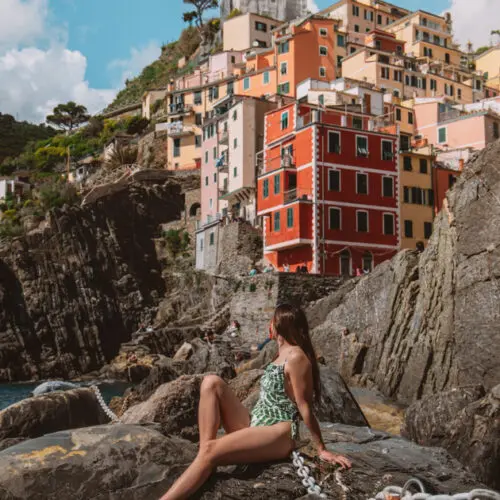Autumn is one of the best seasons for travel for so many reasons, and the autumn in Norway is truly magical. The fjords and beautiful views Norway is known for are made even more beautiful with the fall colours and misty cold mornings. Although the weather can be a little more unpredictable, and you will either find yourself at the top of a mountain covered in snow or enjoying the sunshine by the water, it all adds to the Norwegian autumn experience!
In this post, I have written up our exact road trip itinerary for a 5 day trip from Oslo to Bergen and back. During the trip, we stopped at waterfalls, spent the night in a beautiful cabin and hiked the famous Trolltunga! We have done this autumn road trip through Norway twice, the second time extending the trip for three days by hiking along the Besseggen ride and finishing it off with a drive from Oslo to Gothenburg in Sweden.
The first time we did this drive was in September, here the autumn colours were starting to show through and it was the optimal time for hiking Trolltunga! The weather in Norway in September was cold but we had sunny days. The second time we did this trip, it was October and the weather was much more changeable. We had snow while hiking and it was a lot colder, but the landscape was completely orange which was a lot more striking.
Whenever you do this autumn road trip through Norway, one thing is for sure – the landscape will always be absolutely incredible! So, without further ado, here is the ultimate road trip itinerary during autumn in Norway.
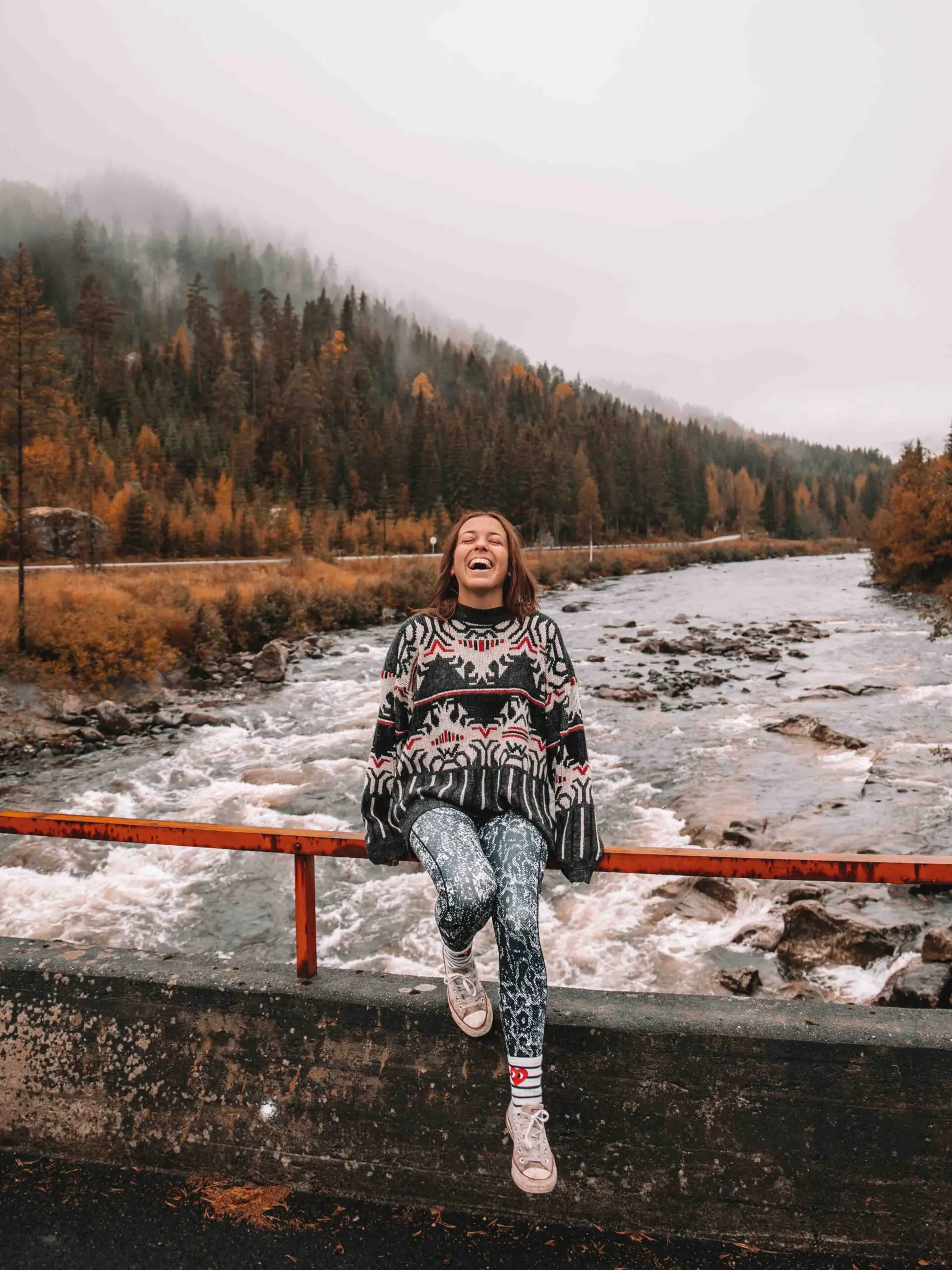


Please note that this post contains affiliate links meaning that if you make a purchase through the link, I receive a small commission at no additional cost to you. I make sure to only ever promote products and brands I have used and like, and that all links are to trusted websites.
The Ultimate Road Trip Itinerary for Autumn in Norway
Day 1: Oslo to Bergen
This 5-day autumn road trip through Norway starts in the capital city of Oslo. We arrived the night before and spent one evening in Oslo before heading out on our road trip the next morning. The first day of the trip includes quite a lot of driving so it is good to get a good night’s rest beforehand!
How long does it take to get from Oslo to Bergen?
The trip from Oslo to Bergen is a total of 7 hours of driving without stopping. However, with stops along the way, this trip took us around 15 hours in total.
The best autumn road trip stops between Oslo and Bergen
This is the best part of the trip for exploring nature and driving through beautiful landscapes! Expect to see lots of fall colours, waterfalls and mountains as we drive to the east of Norway.
Borgund Stave Church
Stave Churches are something quite unique. Built in the medieval style of timber framing, there are only 28 remaining today, and Borgund Stave Church is one of them! The church dates back to the 12th century and is incredibly well preserved.
Borgund Stave Church is located only a short detour off the highway and a must-see stop on your route from Oslo to Bergen! Just down the road, you will find Vindhellavegan, one of Norway’s most beautiful roads.

Vindhellavegan
One of Norway’s most beautiful roads, this winding mountain pass is a historic gem. Reconstructed in 2017, the road is a jump back in time to travel in the 18th century when this was an important road in the region.
To get to the most scenic part of the road there is a 4.5km walk which begins at the Visitors centre carpark by Borgund Stave Church. The hike takes around 1 hour but is definitely worth it!
Lærdalstunnellen
The Lærdalstunnell is the longest road tunnel in the world – a 24.51km long tunnel connecting Lærdal and Aurland. The tunnel has been designed in a special way, with big colourful caves interrupting the long stretches to keep drivers interested and active. It is a really fun experience to drive here. It is also a part of the E16 it is on the route from Oslo to Bergen.
Flåm
Flåm is a beautiful small village at one end of the Aurlandsfjord. The views from here are dramatic, especially as you start the climb the mountain behind and look out over the fjord.
From Flåm you can also catch the Flåmbana, or Flåm railway. This is a popular tourist route – thought to be one of the most beautiful railway journeys in the world. The route starts in Flåm and ends in the mountain town of Myrdal. It is one of the steepest rail journeys in the world – with 80% of the trip at a 5% incline. As you can imagine, the views are incredible!
A round trip on the Flåmbana takes 2 hours and is definitely worth it if you have the time! Myrdal, the end station, is a stop on the Oslo to Bergen rail line meaning if you wanted to take this autumn trip through Norway by train, this is an option!
Stegastein Viewpoint
You will probably recognise the Stegastein viewpoint from any other research you have done about places to visit in Norway. This incredible viewpoint sticks out 30m into the fjord on a 4m-wide platform and gives panoramic views of the dramatic fjord landscape.
By the car park, you will find what is probably Norway’s best public toilet. The side looking out into the fjord is just one big glass window so it really is an experience!
The viewpoint is only just a few minutes drive from the town of Flåm. So you can either drive up or choose to hike up instead. The hike to the Stegastein viewpoint takes around



Day 2: Bergen
For day 2 of this Oslo to Bergen autumn road trip, we will stay in Bergen. This is a beautiful city, surrounded by mountains and fjords.
What to do in Bergen
Hanseviertel Bryggen
Hanseviertel Bryggen is probably the most well-known sight in Bergen, a row of colourful houses by the water with towering mountains behind. This part of the harbour has been on the UNESCO world heritage list since 1979 due to its architectural and transiting history.
If you walk through Bellgården, an alley leading into Hanseviertel Bryggen, you will find Kaf Kafe Bryggen. This is a lovely cafe with great coffee and waffles to warm you up in the cold Norwegian autumn weather.
If you continue down Bellgården you will come across Hanseatiske Museum og Schøtstuene – The Hanseatic Museum and Schøtstuene. This is a great museum about the Hanseatic League and the German merchants that used to visit Bergen between 1350 and 1750. This time was a very important transiting period for Bergen, exporting stockfish and grains, so this museum is a great way to learn a bit more about the history in this part of Norway!
There are so many other lovely shops around this area to explore so make sure to set aside a bit of time for this historic part of Bergen! Don’t miss Margrethe Stinessen Keramikk, a beautiful little ceramic studio, the Theta Museum with its history of Bergen and Norway, and Susan Fosse for some beautiful traditional Norwegian style clothing.
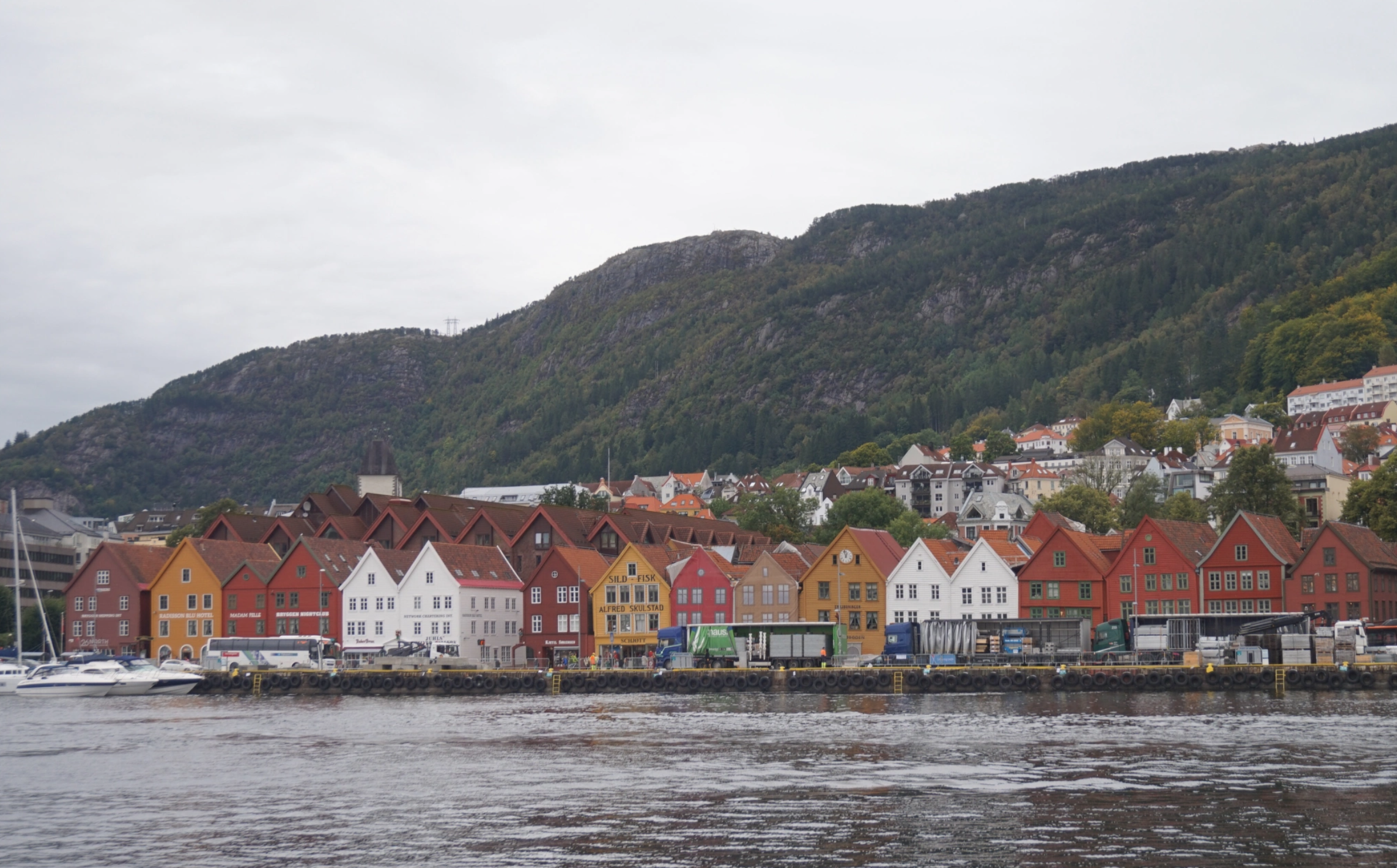
Take Fløibanen funicular railway
The Fløibanan is a funicular railway that takes you from the centre of Bergen up to the summit of Fløyen, the mountain that sits behind Bergen. The funicular railway takes around 5 to 8 minutes but is a great experience. Sitting on the train as you ascend the mountain with an incredible view over the city.
If you don’t want to take the train, it is also possible to drive or walk to the viewpoint. Driving takes 5 minutes from central Bergen while walking takes from 45 minutes to 1 hour.
See Bergen from the water
If you want to spend more time out exploring the Norwegian fjords in their beautiful fall colours then you can instead spend this day on a boat trip. There are a few options here but one I would recommend is this day trip which heads out to Osterfjord and Mostraumen. These are two areas in the north that you will otherwise not see. The boat starts heading out through Osterfjord, a beautiful area dotted with houses and beautiful autumn colours. When it reaches Mostraumen Waterfall, the boat gets so close to the falls that you can feel the water spraying down.
It is a really great experience if you want to experience a little bit more of the autumn in Norway and would rather spend time out in nature rather than walking around the city. The tour takes 3.5 hours so you can easily fit a few activities on either side if you want to do both.
You can find out more about this activity and book it here!
Day 3: Bergen to Odda
During this part of the trip, we cross Hardangerfjord on the car ferry from Tørvikbygd to Jondal. This river crossing only takes 20 minutes but has really breathtaking views! Make sure to get out of the car during the ride and take a look up the fjord!
The ferries leave quite regularly (once an hour) but you can check this website for exact times. Tickets cost around 100kr for a car one way. You do not need to book tickets in advance, but make sure to arrive a little bit before the departure you wish to catch to ensure you get a space on board!
Where to stay in Odda
We spent the next two nights staying at the beautiful Vikinghaug hotel in the middle of Odda. We took the third day of the trip quite slowly, enjoying the area around the hotel and exploring Odda. The hotel is only a few minutes from the beach and has amazing views over the lake Sandvevatnet and the mountains behind it.
You can find this hotel and book it here!
What to do in and around Odda
HM Queen Sonja’s panoramic hiking trail
If you don’t feel like taking this day slow and want a mountain adventure and are happy to hike two days in a row then HM Queen Sonja’s panoramic hiking trail is a great choice. This hike is one of the most popular hikes in Norway, known for its spectacular views over Odda and Sørfjorden as well as forest lands, Norway’s biggest orchard and the Folgefonna Glacier.
This hike is 16km long and takes around 6 – 9 hours to complete. It can be done in the autumn as long as it is good weather – be sure to take this into consideration as it can be dangerous hiking in the snow if you are not prepared. It is recommended that the season for this hike is from June to October.
You can find out more information here!
Waterfall spotting in the Husedalen valley
Another hike, but much shorter this time, is the hiking trail from Kinsarvik up to the Hardangervidda mountain plateau. This is a 5-6 hour hike past four incredible waterfalls in Hardangervidda National Park (5km each way). If you don’t feel like such a long walk, it is possible to walk halfway and turn back which takes around 3 hours.
During the hike in the Husedalen valley you will pass Tweitafossen, Nyastølfossen, Nykkjesøyfossen and Søtefossen. Søtefossen is the highest waterfall.
You can find more information on this hike here!
Norway’s biggest stone
Just around the corner from Vikinghaug Apartments is Norway’s biggest stone (Norges største stein). This rock supposedly separated from the mountain range 10,000 years ago and is today sat on the edge of the lake. It’s a really cool site to see, however, you don’t need to spend much time here.
Explore Oddadalen
Oddadalen is the valley to the south of Odda. This part of the landscape is known as the “waterfall valley”, with 5 impressive waterfalls within a stretch of a few kilometres. These waterfalls are Tjørnadalsfoss, Strandfoss, Vidfoss, Espelandsfoss and Låtefoss.
A drive through Oddadalen is the perfect short trip during Autumn in Norway, a chance to see the fall colours and the rich waterfalls.
Day 4: Trolltunga
Trolltunga is one of Norway’s most famous hikes, known for the rock that hangs out over the fjord below. This is probably on everyone’s Norway Bucket List and it was at the top of mine for a long time.
Driving to Trolltunga from Odda takes around 50 minutes. For us this was ok as we really appreciated the time we had in Odda on day 3 of this autumn itinerary and were happy to head back to a nice hotel after a long day of hiking Trolltunga.
It is possible to stay closer to Trolltunga if you don’t want to do much driving before and after hiking. One of the best options is Trolltunga Skjeggedal. This is quite a cosy holiday house really close to the car park where you begin the Trolltunga hike.
You can find out more and book it here!

When to start the Trolltunga hike
It’s best to start the hike to Trolltunga before 8 am to ensure that it is not dark before you make it back down. We started the hike at 6 am and found it was perfect. It was dark at the start of the hike but we were some of the first to reach the top and we were back in the late afternoon.
Can you hike Trolltunga in the autumn?
It is possible to hike Trolltunga in the autumn, however, they do suggest that September 30th is the last day you should do this hike without a guide. Any later in the year and the track is too dangerous to do alone. The weather can be really unpredictable in Norway in the autumn so you could be hiking up in snow and ice if you do it later.
There are several companies that offer snow-show adventures to the top of Trolltunga in the autumn and winter. Being at the top of a mountain overlooking a fjord completely surrounded by snow is an incredible experience. I definitely recommend it if you are travelling to Norway in the autumn or winter months and are fit enough for the tough walk!
Safety information
If you are planning this hike, make sure you are prepared! The weather can be unpredictable so you should be ready for all sorts of conditions. Wear good hiking shoes, and weatherproof layers and bring enough food to last. There is a water station in the car park where you can fill up bottles.
If you do get into an emergency situation while hiking you can find all the details of who to contact on this page.

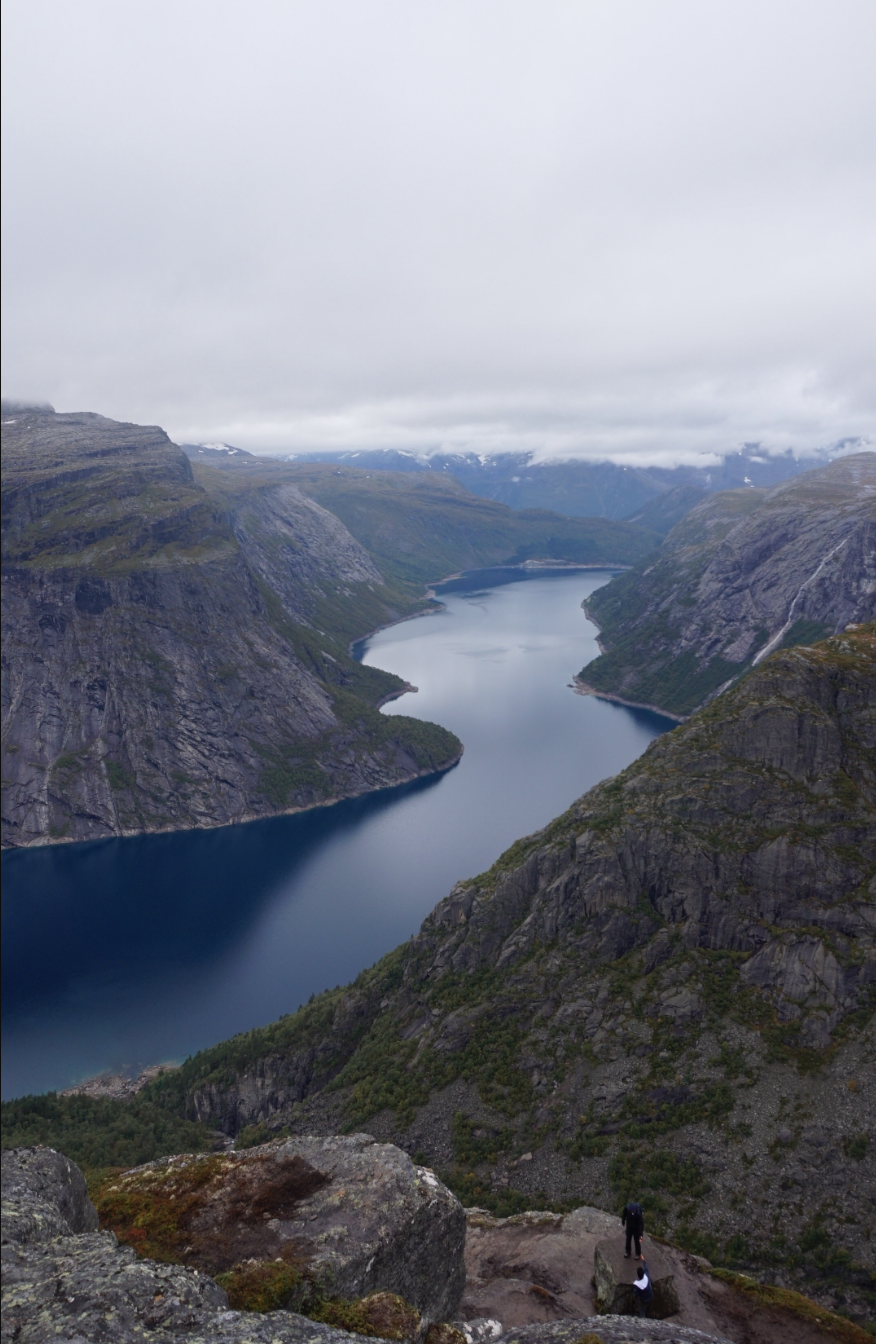

Day 5: Odda to Oslo
We have reached day 5 and the final day of this road trip itinerary for autumn in Norway. Hopefully, the autumn colours, waterfalls and fjords have met your expectations so far! This final day will be spent making your way back to Oslo, following an alternative route from day 1. This drive will take around 5 and a half hours without stops, however, there are some beautiful places to stop on the way back to Oslo so make sure to give yourself enough time.
Oddadalen
If you haven’t already chosen to take a drive down Oddadalen then today is the day! This is a beautiful stretch of countryside spotted with incredible, flowing waterfalls. This is the first section of the drive from Odda to Oslo. Autumn is probably one of the best times to see these waterfalls in Norway as the rainfall is higher and the waterfalls are much stronger than in the few months beforehand.
Røldal waterfall
The second stop on this trip is Røldal waterfall. This is a beautiful mountain waterfall that runs down towards the main road. If you enjoyed stopping at Borgund Stave Church, then make sure to make a stop at Røldal Stave Church! This is of a very similar style, but a little smaller, and dates back to the year 1250.



Turistveg: Austmannalia (Scenic road)
The next stop on the route is the Austmannalia Scenic road. This is a little detour off of the highway but definitely worth it for the amazing views of the surrounding landscape. The road isn’t very long but is worth the trip for a short stop. The road is quite thin and windy so be careful when driving here!
Ståvatn
About 1 and a half hours into the journey, the E134 passes Ståvatn. This is a beautiful stretch of road, typically Norwegian with mountains and lake views, and in the Autumn you can really see the colours come to life.
There are a few places to stop here if you want to take a photo (Rasteplass Vestland Viewpoint, Rasteplass ved Haukeli), but I recommend stopping at Haukeliseter Fjellstue. This is a hotel and restaurant that serves great food with an incredible view. If you want to extend your Autumn trip through Norway I recommend staying an extra night here and trying out some of their activities, or spending some time relaxing in their wilderness spa!
Turistveg: Den gamle Haukelivegen (Scenic road)
The next detour on the route is the Den Gamle Haukelivegen scenic road. This route takes you off the E134 for a short while, while you pass through the mountain landscape. From here you get an incredible view over Kjelavatn lake and its surroundings. This is especially beautiful in the autumn as the whole landscape is different shades of orange and red.
Heddal Stave Church
The next stop is Heddal Stave Church. This is another of Norway’s beautiful Stave churches and probably the most elaborate of those you will see on this trip! This church is Norway’s biggest Stave church and from the outside looks like it is built up of multiple roofs and turrets all stacked upon one another. The church is open from 10 – 4 every day but costs 80 kr for entry.
From Heddal Stave Church it is around 2 hours back to Oslo. The drive continues down the highway until Drammen where you turn onto the E18.
This autumn Norway road trip could be extended by several days if you wanted to include more hikes or days exploring different cities. One great alternative is to head up to Jotunheimen National Park and hike the Besseggen ridge from Gjendesheim. Another option is to spend some more days in Odda enjoying Hardangervidda National Park, or head down to Stavanger from Odda and experience another Norwegian city.

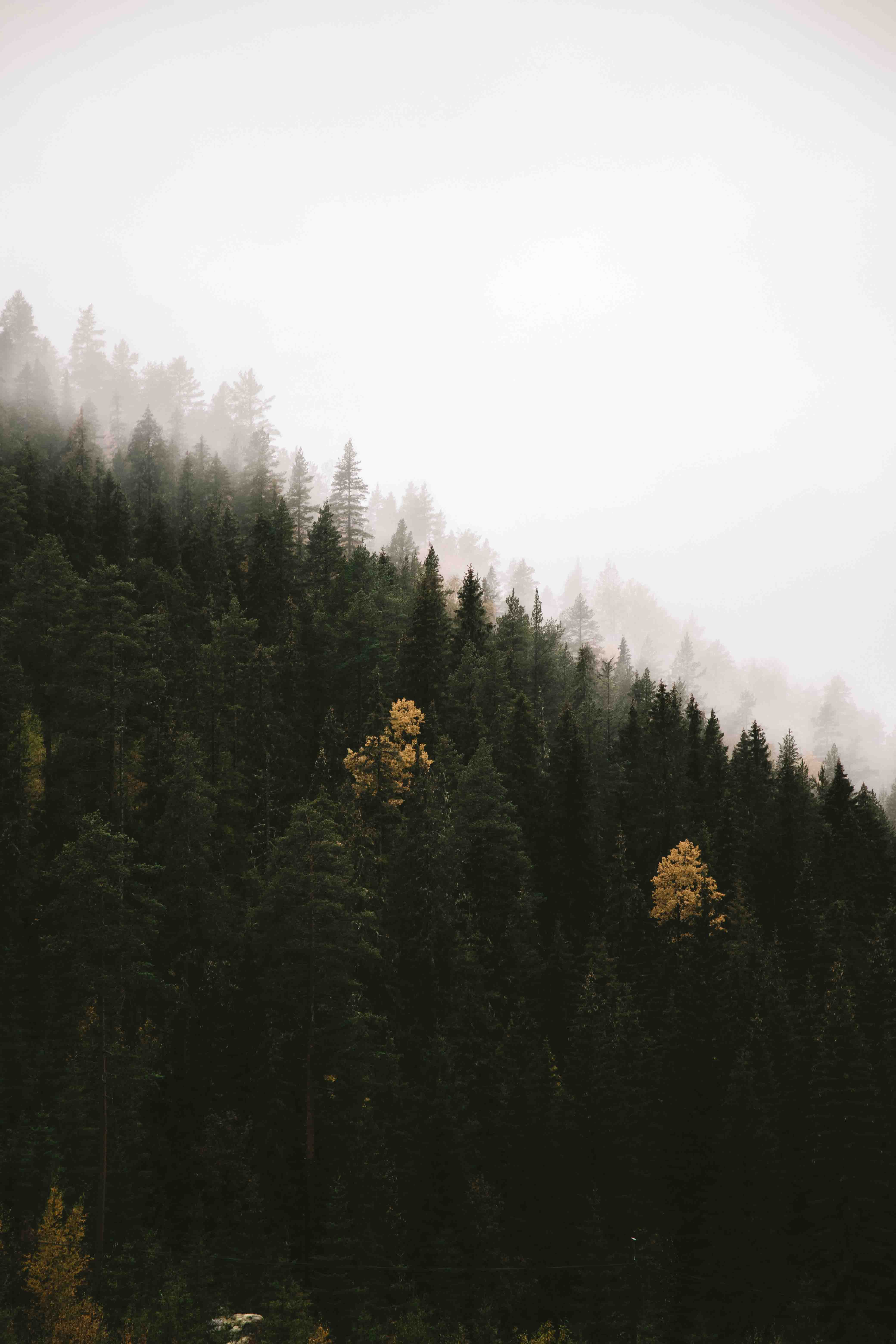

Frequently asked questions
How cold is Norway in autumn?
The temperature during autumn in Norway ranges from 0°C to 10°C. However, it is usually much warmer in the south of the country compared with the north. In September you usually get some warm sunny days, while the end of October can be a lot colder.
What should I wear in Norway in autumn?
When travelling in Norway in the autumn you should be prepared for all types of weather. Make sure to pack jumpers and rain clothes, but also lighter clothes to wear during hikes and warmer weather.
Does it snow in autumn in Norway?
It can snow in autumn in Norway, especially if you are in higher altitudes or in the northern parts of the country. If you are travelling to Norway in early autumn, it’s very possible you will get warmer weather, however, It is always good to be prepared for snow. If you are travelling to Norway in late autumn, it is much more likely.
Is September or October a good time to visit Norway?
September and October can be one of the best times to visit Norway. At this time of year, nature is full of fall colours and the landscape is completely transformed. Most hikes are still possible without a guide until the end of September and the popular destinations are much quieter.
Can you see the northern lights in Norway in autumn?
You can see the northern lights in Norway in the autumn, especially in the north of the country where the days are much shorter. However, it is never 100% that you will see the northern lights, even if you travel in the middle of winter.
What is there to see and do in Norway in autumn?
Travelling to Norway in the autumn, there is so much to see and do! All hikes are still possible, however, if you are travelling in late autumn you may need to take a guide on the harder hikes due to safety reasons. Waterfalls are at their best in the autumn as there is much more rain, and most fjord tours and boat trips still run.
Is this trip possible with public transport?
Yes! This trip is very much possible with public transport. There is a train line which runs from Oslo to Bergen, with the possibility to transfer to the Flåmbana or stop along the water to see different sites. There is a great public transport system in Norway, and although the buses might not be regular, they run throughout the autumn so it is possible to get to most places.
Share this post or save it for later
You might also enjoy these posts
- The Best 4 Day Norway Road Trip Itinerary from Oslo
- Guide to Innerdalen – Norway’s Most Beautiful Mountain Valley
- The Best 10 Day West Norway Road Trip Itinerary
- 10 Day Scandinavia Itinerary – The Perfect Norway, Sweden and Denmark Trip
More posts from travel in Scandinavia
- The Best Things To Do In Lysekil

- The Best Christmas Markets Near Gothenburg (2024)

- A Weekend in Falkenberg – The Best Things To Do

- The Best Boat Trips from Gothenburg

- The Best 3 Day Öland Itinerary

- The Perfect 2 Day Lund Itinerary

- 12 Weekend Trip Ideas for Southern Sweden

- The Best Day Trip to Brännö and Galterö Islands







